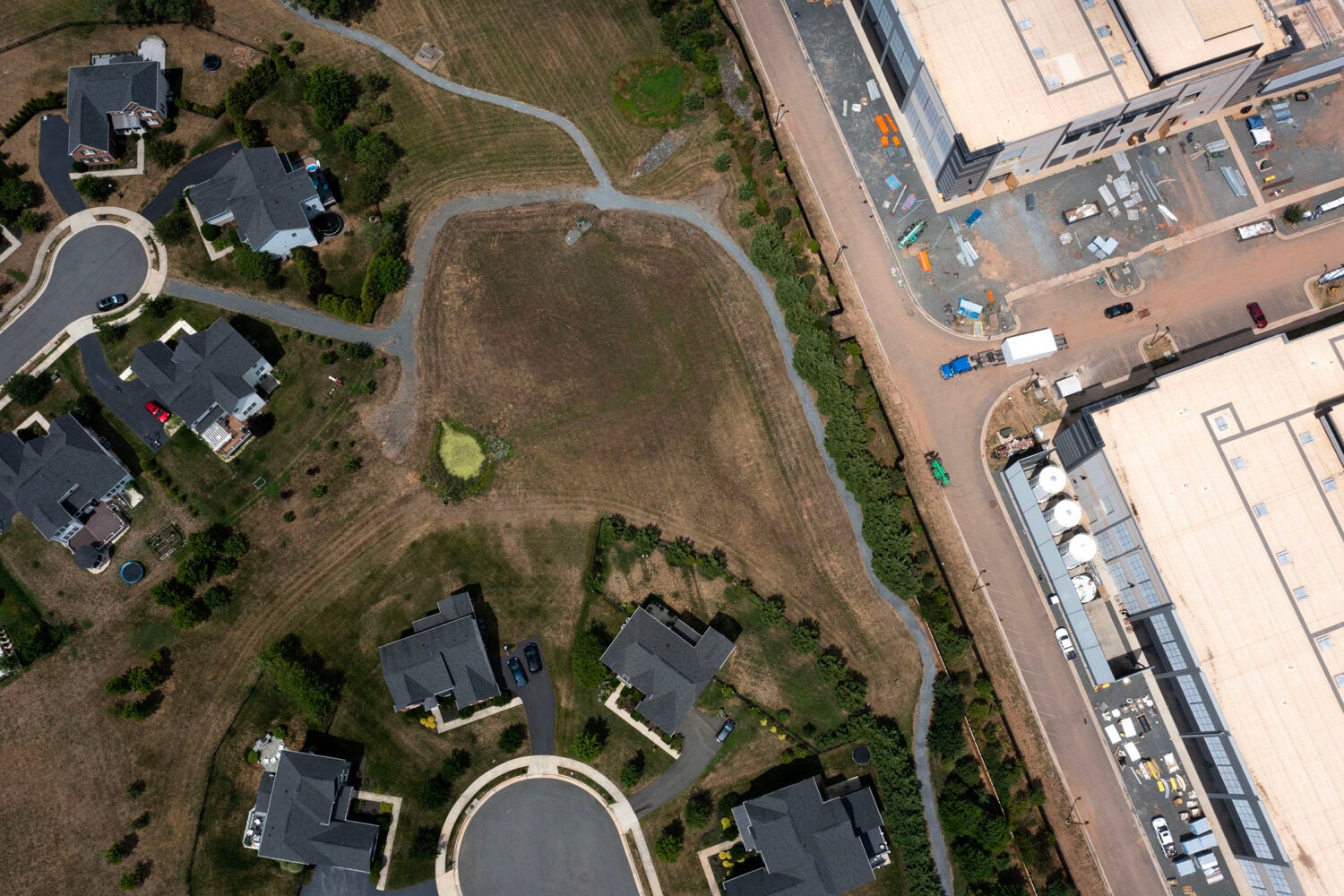What does your favorite chatbot have to do with your higher energy bill? Perhaps more than you think, says Ari Peskoe ’11, director of the Electricity Law Initiative at the Harvard Law School Environmental and Energy Law Program.
It’s no secret that the artificial intelligence business is booming: Last year, U.S. investors poured $109 billion into promising startups and existing companies developing AI tools. ChatGPT alone boasts more than 190 million daily users, and three-quarters of organizations recently reported using AI in some fashion, including for research, content creation, customer service, logistics, and more.
But AI is particularly energy-hungry, requiring enormous amounts of computing power compared to previous technologies, says Peskoe. (One study from MIT estimated that 4.4% of all electricity in the U.S. was consumed by data centers in 2023.) To keep up with demand, tech giants such as Google, Meta, Microsoft, and Amazon are predicted to spend $364 billion this year to accelerate the construction of new data centers across the U.S., with facilities concentrated in places like Northern Virginia, Phoenix, Arizona, and emerging hotspots in Ohio and Nebraska.
State and local officials often celebrate these new computing warehouses, which promise to bring job opportunities, tax revenue, and other economic benefits. But they sometimes come with a price: rising utility rates for their neighbors, including businesses and individual consumers, Peskoe says.
Part of the problem is the data centers’ appetite for electricity, he says. “Facilities under development right now will use more energy than large cities.”
More demand for energy — with no corresponding increase in supply — means higher prices for everyone, Pekoe argues in a paper with Harvard Law legal fellow Eliza Martin. And other consumers often foot the bill for the complicated infrastructure needed to hook these facilities up to the existing system, he adds.
In an interview with Harvard Law Today, Peskoe explains the ways in which data centers sometimes obscure their effect on utility prices, and why state regulators may need to radically rethink their approach to rate-setting if they want to avoid higher energy costs for residents.

Harvard Law Today: Let’s start with the basics. How does the provision of electricity work in the U.S.? Are utilities public, private, or some combination of both? And who sets electricity rates?
Ari Peskoe: About three quarters of Americans get their electricity delivered by a for-profit company whose stock is publicly traded, and the other quarter either receive their electricity from a municipally owned utility, or in many rural parts of the country, they’re cooperatively owned utilities. State regulators — a body of appointed or elected officials — set prices only for the investor-owned utilities. The reason that we need government-set prices is because these companies have monopolies. In most sectors of the economy, competition disciplines price and performance, but when you have a monopoly, that’s just not the case. And because electricity is an essential service, we need some government oversight to make sure that the utility is both providing reliable service and charging consumers a fair and affordable price.
HLT: How, exactly, are rate prices determined in regions served by for-profit electricity companies?
Peskoe: A rate case at a public utility commission has two steps. The first step sets the total amount of money that the utility is going to collect from all of its ratepayers. Utility rates are designed to reimburse the utility for its costs of providing service and provide a government-set profit margin on its capital investments. Step two is figuring out how we’re going to recover that amount from various types of consumers, such as residential, commercial and industrial. And the guiding principle here is cost causation. In general, consumers are divided into different groups based on the differing costs the utility incurs to serve them. With a big factory, for example, the utility might have very different types of infrastructure it needs to provide electricity than to a single-family house. Their energy consumption patterns are different as well — the factory may be using a lot of energy 24 hours a day, whereas at a household level, we’re using different amounts all the time. Various interest groups will try to provide the regulator with evidence for why the utility has a lower cost to serve them, and therefore they should pay a lower rate.
There’s one more piece of all this, which is that there are also different types of fees the utility assesses too. For instance, for residential rate payers, you typically have on your bill a fixed fee, a certain dollar amount per month that you pay, regardless of how much energy you consume. And then you also have a volumetric rate — that is, for each unit of energy you consume, there’s a specific charge associated with that, and that may also vary by time of day for some utilities, so there may be certain parts of the day where energy is less expensive than other parts of the day.
HLT: Why couldn’t data centers be classified under the existing framework?
Peskoe: They might — that’s a decision that the state regulators will have to make, whether to create a separate rate class for data centers. The justification for doing so would be because the utility incurs a different set of costs to serve these data centers as compared to other existing classes of rate payers. It will come down to an empirical question: Is it more expensive for the utility to deliver energy to these data centers as compared to other existing consumers?
HLT: Why might it be more expensive to deliver energy to data centers ? What makes them different from a factory, for example?
Peskoe: It’s the size of these facilities. Facilities under development right now will use more energy than large cities. Their consumption will be so large that even a nuclear reactor would be insufficient to power one of these facilities. There are a handful of industrial facilities that are that large. Many of them came online generations ago, such as oil refineries or aluminum smelters. But there’s not a high growth rate for those types of industrial facilities today in the United States, whereas the growth rate for data centers is astronomical in many parts of the country. Ultimately, owing to both the size of the individual facilities and the fact that some regions are projecting multiple data centers coming online soon, some utilities are predicting that they will double the amount of energy they deliver over the next few years.
“Facilities under development right now will use more energy than large cities.”
HLT: But how can that affect consumers? Why would I pay more for electricity just because a data center in my neighborhood uses more energy?
Peskoe: There are two ways that data centers can raise rates for everyone. First, the utility is building new infrastructure to provide energy to data centers and spreads those costs to all ratepayers. Second, certain energy prices that the utility pays are set through markets, and when demand goes up — and supply doesn’t go up fast enough to meet it — prices go up.
I’ll explain how each one works. When a utility builds infrastructure like poles and wires or power plants, it socializes that cost across all users. That’s been the business model for a century, and it’s generally seen as a fair way to do things. For example, if there’s a tree that falls down and hits a power line in your neighborhood and the power goes out, the utility sends a truck and workers to fix it, but it doesn’t bill you for the repair. Instead, it includes the repair costs in the rates that are paid by everyone. Similarly, if there’s residential growth across the utility’s monopoly service territory, and the utility therefore must build hundreds of millions of dollars of new infrastructure for the new businesses and residents, that cost is spread to everyone. The utility is going to have to build a lot of new infrastructure to be able to generate power and deliver that power. Everyone is going to bear some of that cost. Because data centers consume so much power, utilities are building billions of dollars of new power lines and power plants to supply these industrial-scale facilities. The utility’s traditional approach of spreading infrastructure costs across all ratepayers forces us to pay for costs that the utility incurs only because of the computing facilities.
The other way is, as I said, in many parts of the country, utilities purchase electricity through markets, and those prices are going up because demand is going up in the market, and it takes a while to build new power plants. New industrial computing facilities are causing demand to rise faster than supply. The utility pays more for energy, and accordingly, all consumers pay more.
HLT: If part of the problem is demand for electricity exceeding supply, why don’t utilities just work on increasing supply?
Peskoe: The industry is working to bring more supply online. For a number of reasons, building and connecting new power plants to the system takes too long. The reasons range from supply chain bottlenecks to lengthy studies conducted by utilities prior to connection.
HLT: For their part, those developing these data centers are saying that they will bear the cost of the infrastructure upgrades, but in your paper, you argue that this can be difficult to verify. Why is that?
Peskoe: We all pay electricity prices that are set through rate cases, which are determined via public proceedings where various parties participate and provide evidence to regulators. The utility commission issues a decision in writing that can then be reviewed by a court. Many data centers do not pay those prices. They sign contracts with a utility that provides a special deal, and typically, those contracts are confidential to the public. They’re only available to the utility regulators and anybody that participates in the proceedings to review that contract, if there is one at all. Some states don’t review those contracts.
The reason we should be skeptical that data centers are paying an appropriate rate is because in these proceedings, if there are any, the regulators are only hearing from the utility and the data center. If you’re only hearing one side, there’s no counterargument and the proceeding is biased in favor of the utility and the data center. The other reason to be skeptical here is that regulators exist in a political environment where many state legislatures and state governors support data center investment because they’re billion-dollar facilities that can bring a lot of construction jobs and sometimes local tax revenue. It can be a big political risk for a utility regulator to reject a deal like this.
HLT: In your paper, you outline some ways in which state officials and regulators might think about addressing the problems you raise. What is your key takeaway?
Peskoe: What we really need is a new approach for sharing the costs of new infrastructure. The utility business model is all about spreading costs of system expansion to everyone, because we all benefit from a reliable, robust electricity system. But when it’s a single consumer that is using so much energy — basically that of an entire city — and when that new city happens to be owned by the wealthiest corporations in the world, I think it’s time to look at the fundamental assumptions of utility regulation and make sure that these facilities are really paying for all of the infrastructure costs to connect them to the system and to power them.
Want to stay up to date with Harvard Law Today? Sign up for our weekly newsletter.
